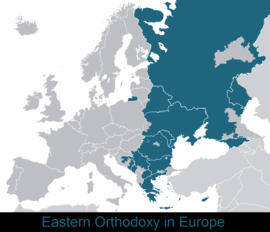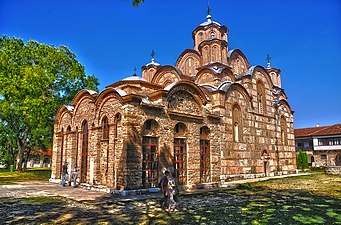Eastern Orthodoxy in Europe
The Eastern Orthodoxy in Europe constitutes the second largest Christian denomination. European Eastern Orthodox Christians are predominantly present in Eastern and Southeastern Europe, and they are also significantly represented in diaspora throughout the Continent. The term Eastern Orthodox Europe is informally used to describe the predominantly Eastern Orthodox countries of Eastern Europe, as well as Greece, Cyprus, and one Caucasus state, Georgia. These include Belarus, Bulgaria, Moldova, Montenegro, North Macedonia, Romania, Russia, Serbia, and Ukraine.

Eastern Orthodoxy in Europe

Eastern Orthodox Monastery of Gračanica
History
Almost all of Eastern Orthodox Europe became part of communist states after World War II.[1]
Eastern Orthodoxy in Orthodox majority countries
- Eastern Orthodoxy in Moldova, 96,8% (2014 census)
- Eastern Orthodoxy in Greece, 90%[2]
- Eastern Orthodoxy in Serbia, 84.6% (2011 census)
- Eastern Orthodoxy in Romania, 83.6% (2015 census)
- Eastern Orthodoxy in Georgia, 83.4% (2014 census)[3]
- Eastern Orthodoxy in Cyprus, 78% (est.)
- Eastern Orthodoxy in Bulgaria, 76% (2011 census)[4]
- Eastern Orthodoxy in Russia, 75% (est.)
- Eastern Orthodoxy in Ukraine, 72% (est.)
- Eastern Orthodoxy in Montenegro, 72.1% (2011 census)
- Eastern Ortodoxy in North Macedonia, 66.7 % (est.)
- Eastern Orthodoxy in Belarus, 48.3% (2011 census)[5]
Eastern Orthodoxy in non-Orthodox majority countries
- Eastern Orthodoxy in Bosnia and Herzegovina, 33% (est.)
- Eastern Orthodoxy in Albania, 20% (est.)
- Eastern Orthodoxy in Latvia, 19.4% (2011 census)[6]
- Eastern Orthodoxy in Estonia, 16.15% (2011 census)
- Eastern Orthodoxy in Austria, 8.8% (2018 census)[7]
- Eastern Orthodoxy in Lithuania, 4.9% (2011 census)[8]
- Eastern Orthodoxy in Croatia, 4.44% (2011 census)
- Eastern Orthodoxy in Slovenia, 2.3% (2002 census)
- Eastern Orthodoxy in Poland, 1.5% (by Wikipedia)
- Eastern Orthodoxy in Finland, 1.1% (2015 census)
- Eastern Orthodoxy in Slovakia, 0.9% (2011 census)[9]
- Eastern Orthodoxy in Norway, 0.22% (2012)
- Eastern Orthodoxy in Hungary, 0.1% (2011 census)[10]
- Eastern Orthodoxy in the Republic of Ireland
gollark: It was easier and cheaper to not get one than it was to get one.
gollark: Not having a microphone is the default option, you see.
gollark: Weirdo.
gollark: _has no microphone_
gollark: projectideasneeded!¬
See also
- Byzantine commonwealth
- Slavic Orthodox
References
- Mary B. Cunningham; Elizabeth Theokritoff (18 December 2008). The Cambridge Companion to Orthodox Christian Theology. Cambridge University Press. pp. 15–. ISBN 978-0-521-86484-8.
- "Religious Belief and National Belonging in Central and Eastern Europe". Pew Research Center. 10 May 2017. Retrieved 2017-09-09.
- "საქართველოს მოსახლეობის საყოველთაო აღწერის საბოლოო შედეგები" (PDF). National Statistics Office of Georgia. 28 April 2016. Archived from the original (PDF) on 5 February 2017. Retrieved 29 April 2016.
- "NSI". Archived from the original on 28 January 2012. Retrieved 24 February 2012.
- Religion and denominations in the Republic of Belarus by the Commissioner on Religions and Nationalities of the Republic of Belarus from November 2011
- "Tieslietu ministrijā iesniegtie reliģisko organizāciju pārskati par darbību 2011. gadā" (in Latvian). Archived from the original on 2012-11-26. Retrieved 2012-07-25.
- "In Österreich leben mehr Orthodoxe als Muslime". 13 September 2018. Retrieved 7 November 2018.
- Department of Statistics to the Government of the Republic of Lithuania. "Ethnicity, mother tongue and religion". Archived from the original on 2014-10-08.. 2013-03-15.
- "Table 14 Population by religion" (PDF). Statistical Office of the SR. 2011. Retrieved Jun 8, 2012.
- "1.26 Population by religion and sex, 1930–1949, 2001". Hungarian Central Statistical Office. Archived from the original on 26 January 2010. Retrieved 21 November 2008.
Sources
- Victoria Clark (21 November 2011). Why Angels Fall: A Journey Through Orthodox Europe from Byzantium to Kosovo. Pan Macmillan. ISBN 978-1-4472-1639-1.
- Jonathan Shepard (2007). The Expansion of Orthodox Europe: Byzantium, the Balkans and Russia. Ashgate Variorum. ISBN 978-0-7546-5920-4.
- Jonathan Sutton; William Peter van den Bercken (2003). Orthodox Christianity and Contemporary Europe: Selected Papers of the International Conference Held at the University of Leeds, England, in June 2001. Peeters Publishers. pp. 92–. ISBN 978-90-429-1266-3.
- Alexandru Duţu (1 January 1998). Political Models and National Identities in "Orthodox Europe". Babel. ISBN 978-973-48-1042-0.
- Kiminas, Demetrius (2009). The Ecumenical Patriarchate: A History of Its Metropolitanates with Annotated Hierarch Catalogs. Wildside Press LLC.CS1 maint: ref=harv (link)
- Obolensky, Dimitri (1974) [1971]. The Byzantine Commonwealth: Eastern Europe, 500-1453. London: Cardinal.CS1 maint: ref=harv (link)
- Ostrogorsky, George (1956). History of the Byzantine State. Oxford: Basil Blackwell.CS1 maint: ref=harv (link)
This article is issued from Wikipedia. The text is licensed under Creative Commons - Attribution - Sharealike. Additional terms may apply for the media files.
